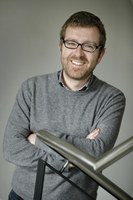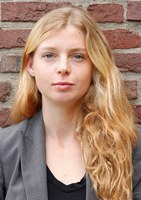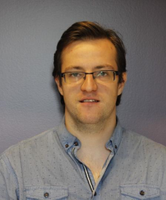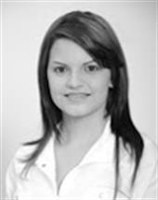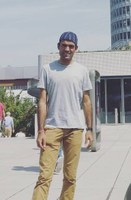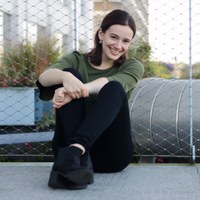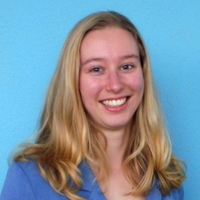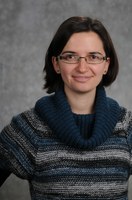2019 Springmeeting
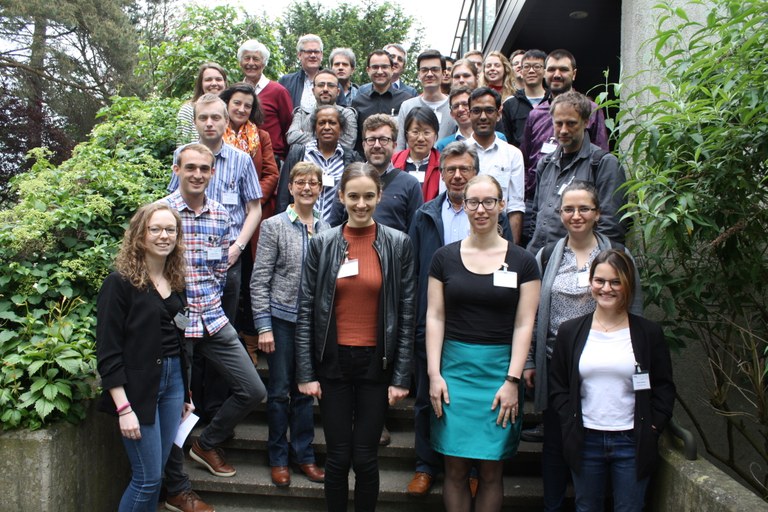
Participants of the 2019 Springmeeting at Campus Groenenborger in Antwerp
Friday May 17th, 2019, the Dutch-Flemish Scientific Computing Society organized its annual spring meeting. This year it took place at CGB, Campus Groenenborger in Antwerp. A mix of young and senior researchers were invited to present their research.
Participation including lunch was free of charge. This year we had 33 participants.
Pictures of the 2019 meeting can be found here. Thanks to Franky Backeljauw from the University of Antwerp for these pictures.
Organization
The spring meeting is organized yearly by the Dutch-Flemish Scientific Computing Society (SCS), this year in cooperation with the research group Computational Mathematics (CMA) of the University of Antwerp.
Organizing comittee: Prof.dr. Annie Cuyt (UAntwerp), Dr. Stefan Becuwe (UAntwerp), Prof.dr.ir. Kees Oosterlee (CWI, TUD), Martine Anholt (CWI, Secretary SCS).
Support for this meeting has been obtained from Centrum Wiskunde & Informatica (CWI) and Computational Mathematics of the University of Antwerp. The Scientific Computing Society is very grateful for that support.
Program 2019
|
09:00-09:30 |
Registration, coffee and tea |
|
09:30-10:10 |
Giovanni Samaey |
|
10:10-10:35 |
Vandana Dwarka (TUD) Scalable solvers and accurate solutions for the Helmholtz Equation
|
|
10:35-11:00 |
Merel de Leeuw den Bouter (TUD) |
|
11:00-11:30 |
Coffee and tea |
|
11:30-11:55 |
Ferre Knaepkens (UAntwerpen) |
|
11:55-12:20 |
Manuela Bastidas (UHasselt) Adaptive numerical homogenization: Anovel approach for simulation of fluid flow in highly heterogeneous porous media |
|
12:20-12:30 |
Group picture |
|
12:30-13:30 |
Lunch |
|
13:30-13:55 |
Nishant Kumar (UTwente) |
|
13:55-14:20 |
Lotte Romijn (TUEindhoven) |
|
14:20-14:50 |
Coffe, tea and refreshments |
|
14:50-15:15 |
Anne Eggels (CWI) |
|
15:15-15:50 |
Mariya Ishteva (VUBrussel) |
|
15:50-16:00 |
Closure |
Speakers Spring meeting WSC 2019
|
|
Giovanni Samaey (KU Leuven) Prof. dr. ir Giovanni Samaey obtained a PhD in engineering sciences at the KU Leuven in 2006. After that, he was active as a researcher at the Université de Lille and INRIA (France), the Université Catholique de Louvain and École des Ponts (Paris). Since 2011, he is a lecturer at the Department of Computer Science at KU Leuven (Division of Applied Mathematics and Numerical Analysis a). He is also an alumnus of the "Jonge Academie" (2013-2018). His research focuses on the development and analysis of new methods to carry out simulations of systems of large numbers of interacting particles, and finds applications in the modeling of tumor growth (the particles are then cells), polymer composites, energy from nuclear fusion (with atoms and ions as particles), traffic flows (with vehicles), and social interactions between people. With colleague Joos Vandewalle, he recently wrote the book 'X Factor' showing the impact of mathematics on society in 20 stories and many anecdotes. For this book, he got a KVAB Science Communications Award in 2018. |
|
|
Vandana Dwarka (TU Delft) Vandana Dwarka has a very diverse background ranging from Law and Econometrics to Mathematics. Following the completion of her third master degree in Applied Mathematics, she decided to focus her efforts on research after having spend several years working in the financial industry and the government. She is currently a PhD-student at the Numerical Analysis department supervised by Prof. Vuik. Her work focuses on finding fast, efficient and accurate solutions to the Helmholtz equation. |
|
|
Merel de Leeuw den Bouter (TU Delft) Merel de Leeuw den Bouter received her BSc and MSc degrees in Applied Mathematics from the Delft University of Technology. During her master's studies she spent one semester at the Massachusetts Institute of Technology.
Currently, she is a PhD candidate in Numerical Analysis at the Delft University of Technology. Supervised by dr. ir. Martin van Gijzen and dr. ir. Rob Remis, she is part of an international, interdisciplinary team that is working towards building a low-field MRI scanner for developing countries. Her research focuses on image reconstruction within the framework of this project.
|
|
|
Ferre Knaepkens (U Antwerpen)
I am a PhD student at the Department of Mathematics and Computer Science of the University of Antwerp. In 2017 I obtained, with greatest distinction, the degree Master of Science in Mathematics from the same university. In view of my strong interest in numerical and applied mathematics, I subsequently started working on a research project with the Computational Mathematics (CMA) group of the University of Antwerp.
|
|
|
Manuela Bastidas (U Hasselt) I am PhD student at the research group of Computational Mathematics at Hasselt University in Belgium. I completed a Master’s degree in Mathematics at the National University of Colombia. My main field of research is numerical analysis. I also worked on areas like artificial intelligence, stochastic process, and flow problems. In all cases, the focus was on mathematical and computational approaches. Currently, supervised by prof. dr. Iuliu Sorin Pop, my work is focused on the simulation of the dynamic behavior of fluids immersed in highly anisotropic and heterogeneous porous media. My goal is to develop mathematical models and numerical schemes to solve multi-scale problems defined in complex domains with evolving interfaces at the micro-scale. |
|
|
Nishant Kumar (U Twente) I am a PhD student in the Mathematics of Computational Science (MACS) group, in the department of Applied Mathematics at University of Twente. After completing my Master’s with a major degree in Geophysics and a minor degree in Mathematics and Computing from Indian Institute of Technology, Kharagpur (IITKGP), I joined the Shell-NWO Computational Science for Energy research (CSER) program. I bring "The Mathematical Systems" community and "The Numerical Mathematics" community together through my research on Discontinuous Galerkin method for port-Hamiltonian systems. My supervisors are Prof. Jaap van der Vegt and Prof. Hans Zwart. |
|
|
Lotte Romijn (TU Eindhoven) I am a PhD student at the Department of Mathematics and Computer Science at Eindhoven University of Technology. Prior to my PhD studies I completed a Master’s degree in Applied Mathematics at the University of Melbourne, Australia. For my Master’s thesis I studied the biomechanics of the small-intestinal crypt by developing computational models of tissue monolayers. My current work is in the field of illumination optics and involves the design of freeform reflector and lens surfaces for LED-based applications, under the supervision of Dr. Jan ten Thije Boonkkamp and Prof. Wilbert Ijzerman. In my PhD studies I focus on developing numerical methods to solve generalized Monge-Ampère equations for a range of optical systems." |
|
|
Anne Eggels (CWI) Anne Eggels studied Industrial & Applied Mathematics at the Eindhoven University of Technology with a focus on fluid dynamics. In 2015 she joined the EUROS program as a PhD at Centrum Wiskunde & Informatica in Amsterdam, where she works on developing uncertainty quantification methods for dependent input variables. One possible application of these methods can be found in wind energy research. She is supervised by prof.dr. D.T. Crommelin and prof.dr.ir. B. Koren. |
|
|
Mariya Ishteva (VU Brussel) Mariya Ishteva is an applied mathematician working in an engineering environment. Since January 2017 she is a research professor (10%) and a postdoc (90%) at the department of Electrical Engineering of Vrije Universiteit Brussel. She has been affiliated with the department since January 2013, including one year as an FWO Pegasus Marie Curie fellow. She works on structured matrix and tensor low-rank approximations and their application for representing, modeling and extracting information from complex data. Her main research interests are in the fields of (multi)linear algebra, system identification, machine learning, data mining, and optimization. |
2019 Abstracts
|
Giovanni Samaey (KUL) |
Nuclear fusion reactor design crucially depends on numerical simulation. The plasma can usually be modeled using fluid equations (for mass, momentum and energy). However, the reactor also contains neutral (non-charged) particles (which are important in its operation), of which both the position and velocity distribution is important. This leads to a Boltzmann-type transport equation that needs to be discretized with a Monte Carlo method. One then obtains a coupled finite-volume/Monte-Carlo simulation, of which the results possess both a bias and a variance. In this talk, I introduce the problems associated with the simulation of the plasma edge region in a fusion reactor. I discuss how to couple a finite volume discretisation of the plasma equations with a Monte Carlo simulation of the neutral particles, and show how theMonte Carlo errors affect convergence of steady state computations and reliability of gradient computations (necessary during optimization). |
|
Vandana Dwarka (TUD) |
Recent research efforts aimed at iteratively solving the Helmholtz equation has focused on incorporating de ation techniques for GMRES-convergence accelerating purposes. The two-level-de ation preconditioner combined with Complex Shifted Laplacian Preconditioner (CSLP) showed encouraging results in moderating the rate at which the eigenvalues approach the origin and cause the solver to slow down. However, for large wave numbers the initial problem resurfaces and the near-zero eigenvalues reappear. Our ndings reveal that the reappearance of these near-zero eigenvalues occurs if the near-singular eigenmodes of the ne-grid operator and the coarse-grid operator are not properly aligned. This misalignment is caused by accumulating approximation errors during the inter-grid transfer operations. We propose the use of higher-order approximation schemes to construct the de ation vectors. The results from Rigorous Fourier Analysis (RFA) and numerical experiments conrm that our newly pro-posed scheme outperforms any de ation-based preconditioner for the Helmholtz problem. In particular, the spectrum of the adjusted preconditioned operator stays xed near one. For the rst time, the convergence properties for very large wavenumbers (k = 10^6 in one-dimension and k = 1500 in two-dimensions) have been studied, and the convergence is close to wave number independence. The new scheme additionally shows very promising results for the more challenging Marmousi problem. Another focus of our work has been on researching the pollution error for the Helmholtz equation. Due to numerical dispersion, a large error can be present between the exact and numerical solution. As a result, fast solvers might be computing wrong solutions. Classical pollution studies focus on eliminating the error using higher-order discretization schemes. Our new approach focuses on the pollution error in terms of the eigenvalues. We propose a new, yet sharp bound for the pollution error. Moreover, using this new method, it is possible to reduce the pollution error signicantly using the eigendecomposition. |
|
Merel de Leeuw den Bouter (TUD) |
In low-field MRI, the image reconstruction problem is ill-posed. To obtain an acceptable solution, adding a regularization term to the least squares problem is necessary. The resulting minimization problem is usually solved using Conjugate Gradient Least Squares (CGLS), but we present an alternative: a generalized version of the Conjugate Gradient Minimal Error (CGME) algorithm. Analysis of the convergence of generalized CGME and CGLS shows that CGME can be expected to perform better for ill-conditioned regularization matrices. When an Lp regularization term is used and the minimization problem is subsequently solved using Iterative Reweighted Least Squares, we expect the regularization matrix to become more ill-conditioned with every iteration, which would make CGME the method of choice. The MRI physics in a low-field scanner were simulated to generate a dataset. Numerical results show that CGME outperforms CGLS in terms of the number of iterations and computation time required to attain convergence, indicating that CGME is a very promising alternative to CGLS. |
|
Ferre Knaepkens (UA) |
Exponential analysis is termed an inverse problem because it consists in extracting an exponential model's linear and nonlinear parameters from a limited number of observations of the model's behaviour.
Already, in 1795, the one-dimensional problem was solved by de Prony. The multivariate problem is far less developed. When the dimensionality of a problem increases, the amount of required input data often grows exponentially with the dimensionality, a phenomenon referred to as the curse of dimensionality. Only in 2017, the UA research group CMA developed a method for exponential analysis which does not suffer from the curse of dimensionality. It can actually solve the multidimensional problem from the theoretical minimum number of samples. Another great UA-CMA breakthrough is the ability to recover signals from sub-Nyquist sampling, meaning a much lower sampling rate can be used than requested by the fundamental Nyquist theorem. Both breakthroughs offer great benefits for several applications. Exponential analysis sounds remote but touches our lives in many ways: exponentials with real exponents appear in chemical reactions and physical phenomena, while signal processing is all about exponentials with complex exponents. In particular, we focus on direction of arrival (DOA) and inverse synthetics aperture radar (ISAR). In DOA, a uniform linear antenna array receives some signals from several sources. The objective is to obtain the angles between the sources and the antenna array. ISAR is a radar technology that utilizes the movement of a target to detect its location from the backscattered signal.
|
|
Manuela Bastidas (UH) |
Many real-life applications are involving fluid flow through porous media. In most of the cases, the porous medium has a highly heterogeneous behavior. This makes the development of efficient numerical simulation methods a challenging task. In general, standard numerical methods willbecome inefficient because it requires a mesh that is fine enough to reproduce the rapidly changing characteristics.In this context, multi-scale techniques are a good compromise between accuracy and computational complexity. Here we present a numerical scheme for approximating the solution of effective (homogenized) modelsat the macro-scale.We usethe mixed finite element formulation schemeand an error estimator to perform a local mesh refinement in order to improve the accuracy of the solution, butwithout affecting the efficiencyof the method.Finally, we discuss the applicability of this approach to other problems,like the reactive flow and transport in porous media. |
|
Nishant Kumar (UT) |
Since a long time, the numerical mathematics community has been trying to develop numerical methods that would give the flexibility of choosing different functional spaces for different physical variables and at the same time preserve the mathematical structure of the PDE. To this I will bring forward the idea of looking at the PDE in a geometrical way and to represent it as a port-Hamiltonian system. Using the fact that port-Hamiltonian systems are based on the idea of energy conservation and that the interconnection of port-Hamiltonian structures is again a port-Hamiltonian system, I propose to use discontinuous finite elements and then consider each finite element as a port-Hamiltonian system. In this talk I will discuss the idea and construction of this novel framework of port-Hamiltonian Discontinuous Galerkin Finite element methods. I will also discuss how this framework cab be applied to the acoustic wave equation and how it can accurately solve the wave equation for long periods of time and over long distances. |
|
Lotte Romijn (TUE) |
I present a method for the design of a single reflector/lens optical system that transfers the given light distribution of a point source to a desired target distribution in the far field. The design of the free -form surfaces is based on the partial differential equation for the optical map that corresponds to energy conservation. This partial differential equation is a fully non-linear second order partial differential equation and known as a generalized Monge-Ampère equation. The mathematical theory under lying the transport of light from source to target is related to optimal mass transport, with the aim of finding an optimal plan which minimizes a transport cost functional . Previous work on Monge-Ampère equations in optics has been applied to a limited set of optical systems. Each optical system corresponds to a different generalized Monge-Ampère equation and associated cost function in the optimal mass transport problem. Nearly all existing algorithms work for quadratic cost functions. The point source corresponds to a logarithmic cost function and does not fit into this framework. We use a least - squares algorithm that can handle a non - quadratic cost function by extending current algorithms to a more general case, taking into account the relation between the optical map, the cost function and the surfaces that describe the optical system. |
|
Anne Eggels (CWI) |
Uncertainty quantification (UQ) is a rapidly growing research area which considers the quantification and reduction of various types of uncertainties in computational and real-life systems. Dependencies in the input variables are an important but often neglected aspect of these systems. One can think of systems in which the input variables obey physical laws or are an outcome of earlier systems. During my PhD I developed a complete framework of UQ methods, including uncertainty propagation, dependency and sensitivity analysis, which are able to handle such dependencies. I will describe the individual elements of this framework and illustrate them by an example of uncertainty in wind and weather conditions affecting the power output of an offshore wind farm |
|
Mariya Ishteva (VUB) |
Tensor decompositions for data modeling and interpretation Data are often naturally multi-dimensional (multi-way). A promising tool for dealing with such data is the generalization of matrices to higher-dimensional arrays of numbers, called higher-order tensors. Tensor techniques are becoming increasingly important in various research domains, including data mining, machine learning, and signal and image processing. Such techniques have the potential to handle complex systems where existing methods fail. Moreover, models are given physical or intuitive interpretation and the number of parameters is drastically decreased. Finally, as there already exist a number of tensor toolboxes for Matlab, tensor methods can readily be used. We present an overview of tensor decompositions, algorithms and some applications. We also briefly discuss a generalization of the singular value decomposition to a decomposition of nonlinear functions. |



